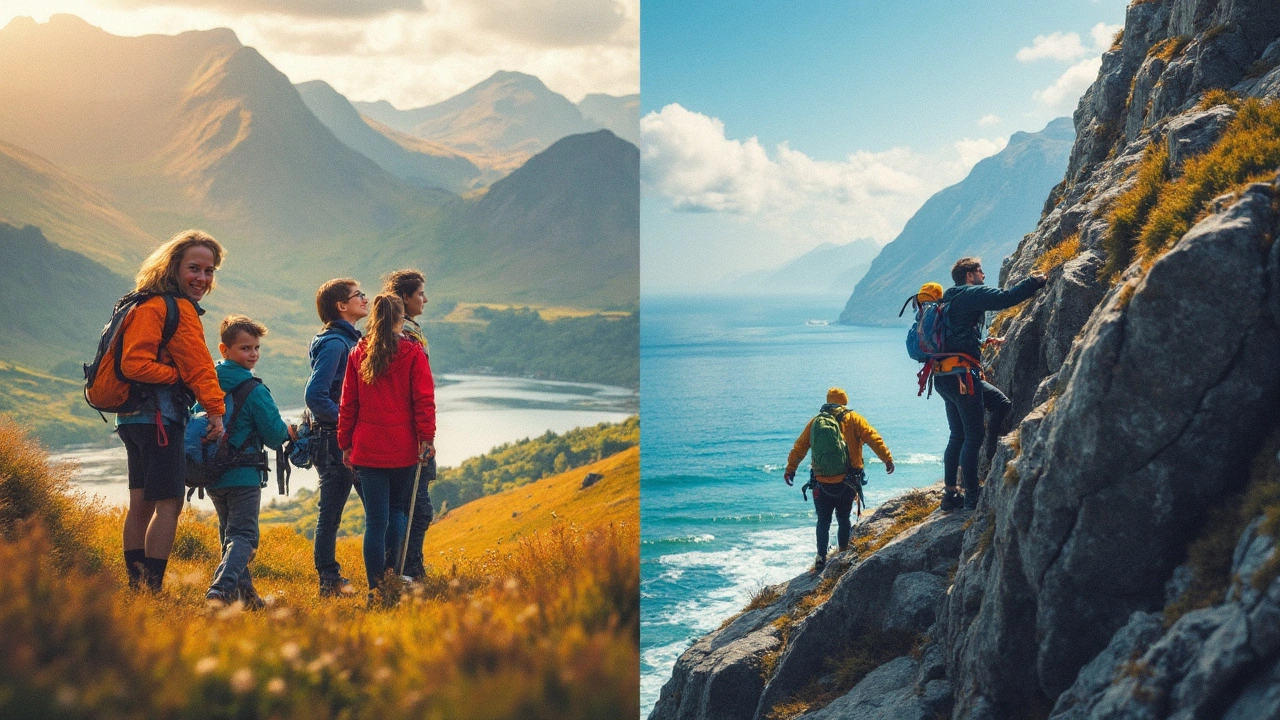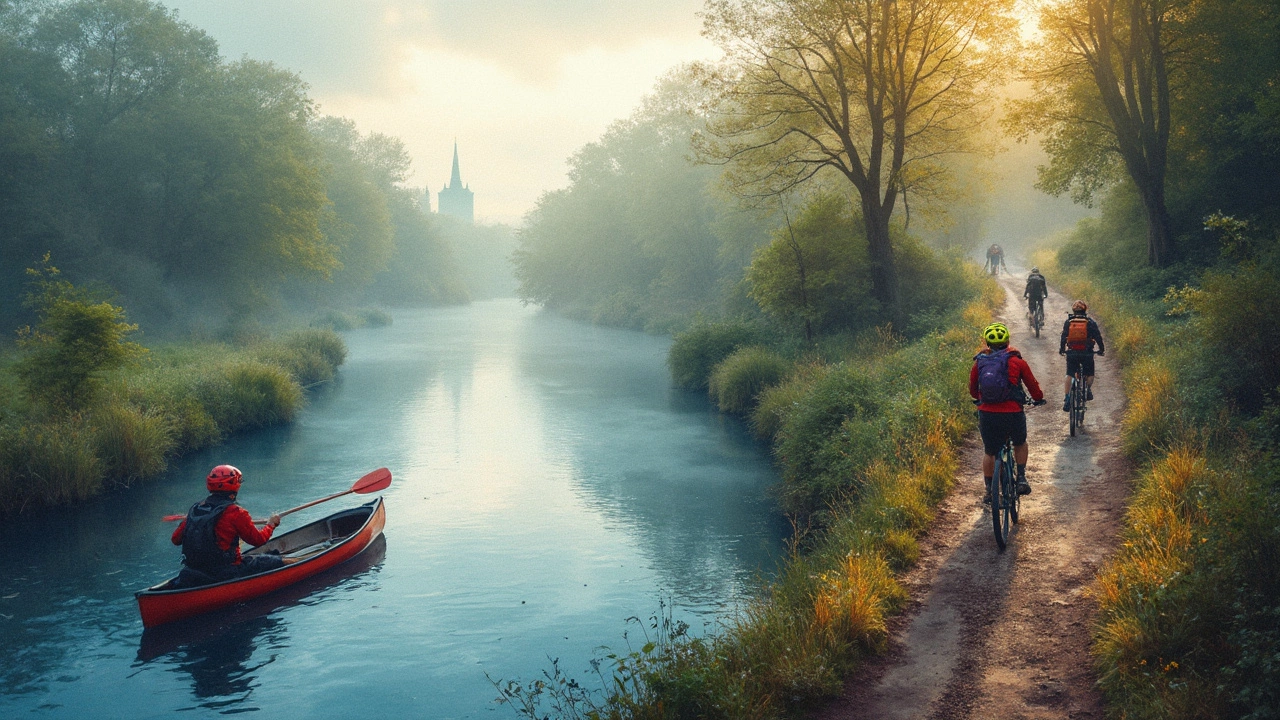Adventure Travel Types: Soft vs. Hard Experiences Explained
 May, 9 2025
May, 9 2025
Thinking about adventure travel but not sure what you’re actually signing up for? You might picture mountain climbing in the Himalayas or maybe just ziplining in Costa Rica. Both fit the definition, but there’s a world of difference depending on how wild you want to get. Knowing the two types—soft and hard adventure—can make all the difference in planning a trip that makes you excited, not anxious.
Soft adventure is for folks who love new sights and maybe a little adrenaline but want to stay mostly safe and comfortable. Hard adventure? That’s where you’re more likely to end up hanging off a cliff or battling whitewater rapids. There’s no “better” type—just what works for you and whoever you’re traveling with. Picking the right one saves you from biting off more than you can chew, or worse, getting bored on your once-in-a-lifetime trip.
- What Makes Adventure Travel Special?
- Soft Adventure: Low Risk, Big Smiles
- Hard Adventure: High Thrills, Serious Skills
- Which Type Is Right for You?
- Getting the Most Out of Your Adventure
What Makes Adventure Travel Special?
Adventure travel stands out because it breaks away from the usual sightseeing and lazy hotel pools. It's about doing, not just looking. Whether you're trekking through Patagonia, ziplining in Thailand, or learning how to surf in Portugal, you're part of the experience, not just watching it happen around you.
It’s not just for thrill-seekers, either. According to the Adventure Travel Trade Association, more than 50% of travelers pick trips that push them out of their comfort zone, but not always to the extreme.
“True adventure travel is about personal growth, cultural connection, and getting hands-on with the world,” says Shannon Stowell, CEO of the Adventure Travel Trade Association.
This category of travel can help you build confidence, learn new skills, and get to know cultures from a different angle. It can even improve your health—studies from the Global Wellness Institute say active trips lower stress and boost mental sharpness.
So why choose adventure travel over a regular holiday? Here are some reasons:
- It often takes you to spots most tourists never see.
- You get real-life stories and skills to brag about later—think kayaking, rappelling, or even basic survival techniques.
- Many adventures are built around eco-friendly, local experiences, so you’re not just a visitor, you’re part of something bigger.
- You face challenges that make each day memorable, not just a blur of photos.
Adventure travel can sound intimidating, but at its core, it’s about saying yes to something new, whatever your age or level of experience. With the right planning, you’re almost guaranteed to bring home more than just souvenirs—you’ll get memories that stick with you forever.
Soft Adventure: Low Risk, Big Smiles
Soft adventure is perfect if you want some excitement without having to train like an Olympic athlete. With soft adventure, you look for experiences that stretch your comfort zone just a bit but don’t require special skills or risky decision-making. Things like hiking easy trails, cycling through vineyards, snorkeling in shallow waters, or even going on a wildlife safari count as classic soft adventure travel.
The best part? Most of these activities are family-friendly and don’t need fancy gear or months of planning. In fact, according to a 2024 report from the Adventure Travel Trade Association, over 60% of travelers chose soft adventure for their last holiday—think whale watching in Iceland or kayaking in calm bays. These activities are considered low risk because local guides keep things safe and provide most of what you need, like helmets or life jackets.
Here are some common soft adventure activities you might want to try:
- Hiking established trails in places like national parks
- Ziplining over scenic forests
- Guided biking tours in the countryside
- Sailing or gentle rafting on slow-moving rivers
- Snorkeling or swimming in tropical lagoons
- Hot air balloon rides above beautiful landscapes
Packing for soft adventure is refreshingly simple. Bring comfortable clothes you can move in, a solid pair of shoes, sunscreen, and a refillable water bottle. Most tours provide any special equipment. To get the most out of it, check reviews for tour companies and ask if you need to prep anything or bring certain items.
So, if you’re curious about adventure travel but worried about your fitness level or safety, soft adventure has your back. It’s all the thrill with very little risk, so you can focus on fun instead of fear.

Hard Adventure: High Thrills, Serious Skills
Hard adventure isn’t for the faint-hearted. We’re talking about activities that get your heart racing and your body working overtime—stuff like rock climbing, ice climbing, mountaineering, white-water rafting, deep cave exploring, and skydiving. These experiences usually take you far from the nearest hospital and rely on real know-how, physical strength, and mental grit. You have to plan, train, and sometimes get certified before you even show up. The risks are much higher than with soft adventure, so making smart choices is key.
If you’ve ever seen someone dangling from a cliff or charging down Class V rapids, you get the idea. Let’s put it in perspective: climbing Mount Everest has a success rate of about 30% each season and, as of April 2024, the fatality rate is still roughly 1%—way higher than most other adventure activities. Hard adventure sports aren’t just about the thrill—they demand focus, prep, and respect for the elements.
- Adventure travel companies often require medical checks and waivers for hard adventure trips.
- Insurance costs—especially for stuff like mountaineering or scuba diving—are much steeper.
- Training is non-negotiable; you’ll need to prove your skills or take a course first.
- Many destinations have rules on equipment, local guides, or safety standards, so you can’t just jump right in.
To give an idea, here’s a simple table showing estimated injury rates per 1,000 participants per year for popular hard adventure sports:
| Activity | Estimated Injury Rate (per 1,000) |
|---|---|
| White-water rafting | 2-4 |
| Mountain climbing | 8-12 |
| Scuba diving | 1-2 |
| Skydiving | 0.3-0.8 |
The best tip? Don’t skip training, however tempting it may seem. Talk to folks who’ve done it before, read reviews, and make sure your travel insurance actually covers your chosen epic quest. Stick with certified guides, take safety briefings seriously, and be honest about your health and fitness. The payoff: moments you’ll never forget and skills you’ll actually keep using.
Which Type Is Right for You?
Picking between soft and hard adventure travel isn’t just about your fitness. It’s about what gets you genuinely excited and what you can handle physically and mentally. Love a challenge and don’t mind roughing it? Hard adventures like multi-day trekking, mountaineering, or deep-sea diving might suit you. If you’d rather try something fun but safe—like hiking scenic trails, gentle kayaking, or wildlife safaris—soft adventure is your sweet spot.
Ask yourself a few key questions before booking:
- What’s your comfort zone with risk and physical effort?
- Are you up for dealing with unexpected situations (like bad weather, minor injuries, or navigation challenges)?
- Do you feel okay with being far from help, or do you prefer access to amenities?
- How much prep work do you want to put in—are you willing to train, or do you want to just show up and have fun?
If you have medical conditions, always check with your doctor—some hard adventures have strict health requirements. Age isn’t a blocker, but kids, seniors, and those with mobility issues should usually stick with soft adventures. Tour operators are pretty honest with their level ratings now, so pay attention to those: "beginner," "intermediate," and "advanced" tags really do matter.
When in doubt, start with a soft adventure. You can always ramp up your next holiday once you get a taste of what you like. No shame in keeping it chill—soft adventure trips aren’t just for first-timers. They’re perfect for folks who want cultural experiences, time in nature, and a bit of a buzz without risking life and limb.

Getting the Most Out of Your Adventure
If you want your trip to be fun instead of frustrating, a little prep goes a long way. No matter if you’re after soft or hard adventure travel, some basics stay the same: get clear on what’s involved, pack the right gear, and listen to your guides. Most accidents on adventure trips come from ignoring instructions or being overconfident, not from the activities themselves.
You’ll want to think ahead about fitness too. According to a 2023 survey from the Adventure Travel Trade Association, 70% of injuries on guided trips happened to people who overestimated their skill level. If you’re signing up for mountain biking in the Alps, make sure you’ve biked somewhere a bit hilly first.
Here's what you can do to make your adventure smoother:
- Read the full itinerary and ask questions—no one ever regretted knowing too much.
- Tell organizers about health conditions or dietary needs right away.
- Take copies (digital and paper) of your passport, insurance, and emergency contacts.
- If you're renting gear, double-check the fit and condition before you head out.
- Pay attention to weather and bring layers. Even desert hikes can have freezing nights.
Curious how most people prep? Take a look at these stats from recent adventure trips:
| Preparation Step | Percentage of Travelers Who Did This |
|---|---|
| Booked pre-trip fitness training | 32% |
| Checked weather forecast daily pre-departure | 78% |
| Joined a group info session before the trip | 41% |
| Bought travel insurance specific to activity | 67% |
The biggest tip: stay flexible. Stuff happens—flights change, trails close, your kayak flips. If you go in with an open mind and curiosity, you’ll come home with stories you actually want to tell.
